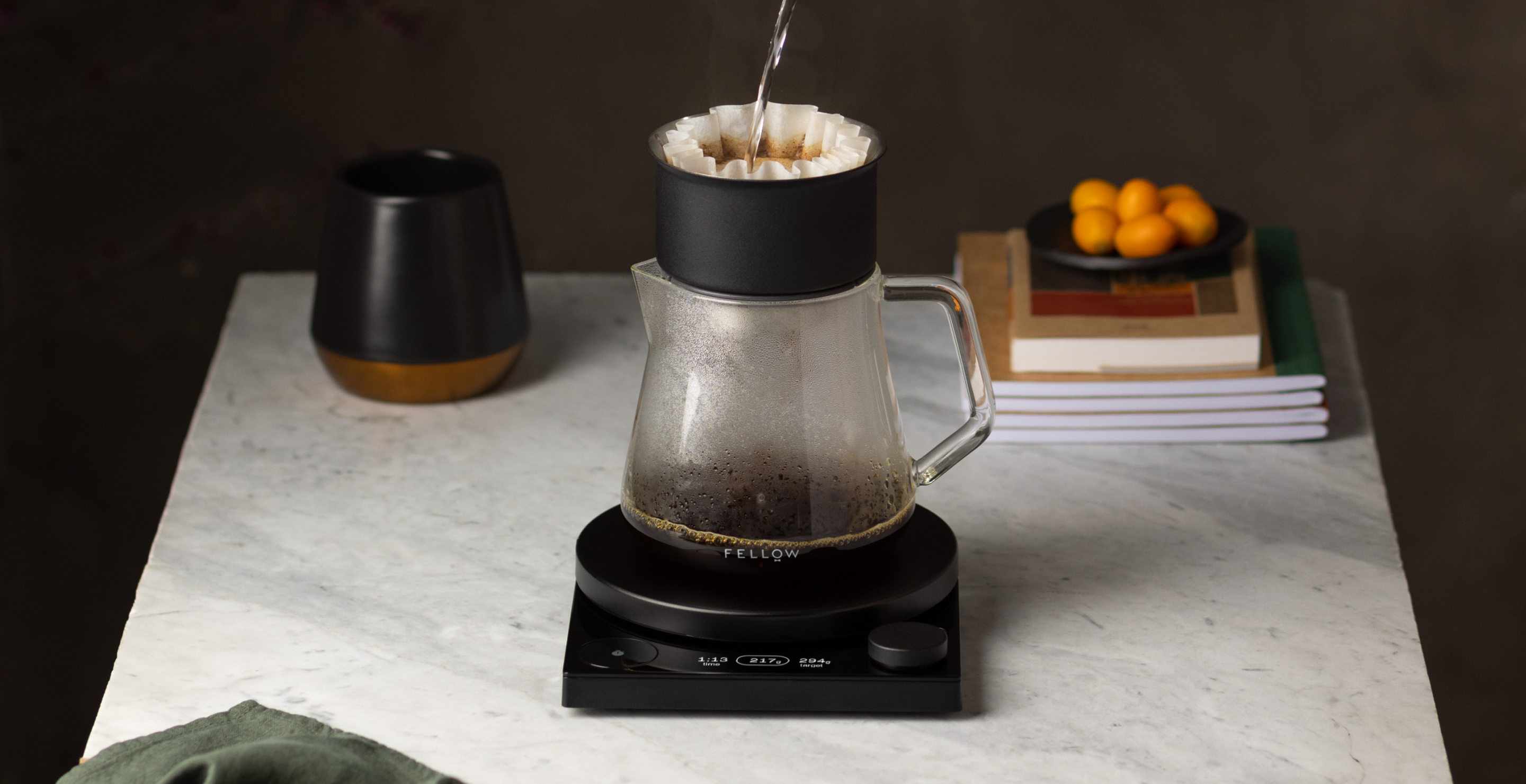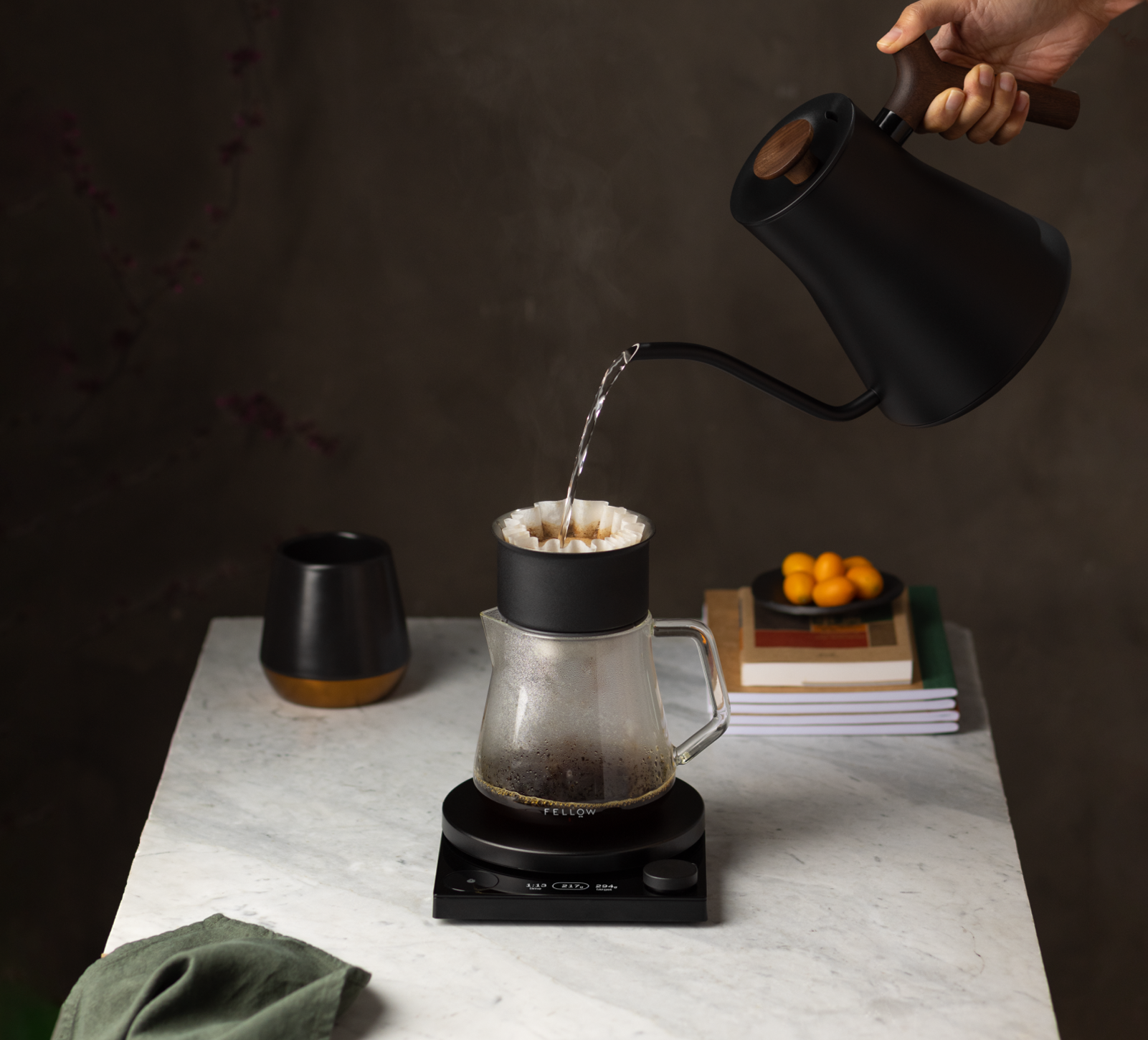In manual home coffee brewing, two methods reign supreme: the pour-over and the French press. Depending on your time constraints, patience, tools, flavor preferences, and current coffee stockpile situation, one method may be better. If you're unsure of which one to choose, this guide will help you compare the two options.
French Press vs. Pour-Over: What's the Difference?

Also known as a cafetiere, the French press coffee pot has been around since the mid-1800s when a Frenchman boiled water for coffee. Legend has it, he neglected to put the coffee into the pot, so he added it once the water was boiling. He used a metal screen to filter the beverage and didn't expect it to be such a delicious cup of coffee, but it was. The French press wasn't patented until 1929 by an Italian inventor, and since then, it's been improved in a number of ways.
The French press is a form of immersion brewing. The coffee grounds and water mix directly together for much of the brewing process, typically about four minutes, before being filtered out using the metal mesh in the device’s plunger. The resulting coffee is typically bold and rich in flavor.
The pour-over coffee idea started with Amalie Auguste Melitta Bentz in Germany in 1908. As a housewife who wasn't content with the bitter coffee her percolator produced, she decided to try another method to brew coffee and realized the immense difference between her creation and the standard percolators of the time.
In pour-over, coffee grounds are placed in a pour-over dripper with a filter and water is poured over the top of it. The coffee trickles slowly into a carafe or cup at the bottom. There are numerous sizes and shapes of pour-over drippers out there, from cone-shaped Hario V60s, to flat bottomed drippers such as the Kalita Wave or our very own Stagg Dripper. The resulting coffee is characterized by lighter, brighter notes than immersion brewing and espresso.
Pour-Over Advantages and Considerations

There are numerous pros and cons to this coffee pot to determine if it's the right one for you.
Advantages. Pour-over is one the best brewing methods for specialty coffee because it allows the coffee’s unique flavors to shine through. As the coffee world has become more meticulous in its sourcing and processing of coffee, this method has taken hold as the best way to showcase the origin and flavors of each coffee.
Whenever you use this brewing process, you get the unique flavors from different types of coffee that are often overlooked with a standard percolator. Specifically, you'll receive all the natural flavors of each variety of bean, especially because you have full control over the process.
The correct filter removes all the coffee oils and sediments of the coffee. These give the coffee a bitter taste, so by removing them, you achieve a more perfect cup of coffee. In general, the pour-over process creates a better-tasting coffee than a standard percolator.
You can decide on how much coffee you want to make because you can purchase coffee makers that brew anywhere from one to eight cups of coffee at a time.
Considerations.
Overall, the pour-over method takes patience and technique. It’s a hands-on process that you need to be present for, and has multiple steps. It may be intimidating to begin with, but over time you may find the process becomes meditative and soothing, five minutes of your morning purely dedicated to a quiet and artful process, with delicious results. If you’re just starting out, you’ll need to equip yourself with specific tools, most notably a gooseneck kettle, as the rate of flow from a regular kettle is not ideal for pour-over, plus a coffee scale so you can follow recipes and ensure the optimal proportions of coffee and water. You’ll also need to always ensure you have coffee filters in stock!
French Press Advantages and Considerations

Like pour-over coffee, French press has several perks and drawbacks.
Advantages. As with a pour-over coffee process, you receive a delicious cup of coffee with a French press. The coffee has an incredibly rich, smooth flavor. Additionally, when you use this method of brewing coffee, you have more control over the flavor of your coffee.
Overall, when you compare it to other brewing methods, this is a cost-effective method since it doesn't require you to purchase filters. The filter is built into the press.
This is a popular method of percolating coffee for campers because the pot is portable, and you can find them in completely metal versions. It's also portable in general when you consider you need little to make coffee when you utilize this method.
These pots are available in different sizes, so you can find one that's most suited to how much coffee you want to make at a time. Typically, the pot is either designed for three, four, or eight cups.
Disadvantages. Coffee made with a French press takes about four minutes to brew. This isn't counting the time you spend grinding the beans and boiling the water. You need coarsely ground coffee for a French press to work properly.
While some coffee connoisseurs rave about the finished product, it produces a strong-tasting coffee with a bit of an earthy aroma. This may be off-putting for someone with no experience brewing coffee in this manner.
When you use a French press with a glass pot, it's easily breakable during cleaning. You can alleviate this problem by using a metal pot, though.
Sometimes, you get grounds in your coffee when you use the French press brewing method.
Further Comparison
Essentially, either device can produce a tasty cup of coffee. Both methods take longer than making a standard pot of coffee in an electric percolator and may require more patience, clean-up, and maintenance. However, between the two of these coffee-making methods, each one has certain attributes that may make it better suited.
Is French Press or Pour-Over Easier? It's a matter of preference which one you find easier. Each method is relatively easy to catch on to once you learn its basic steps. With that being said, the French press is a bit easier to use. This is especially the case if you're using this type of coffee maker in the morning when you first wake up.
Is French Press or Pour-Over Faster? While both coffee makers take longer than an electric one, the French press is a quicker method of making coffee, especially since there is a lower wait time and less work you need to do.
Is the Ratio for French Press Coffee and Pour-Over Coffee the Same? French press coffee uses a higher ratio for coffee than pour-over coffee devices. The standard kitchen formula is 16 ounces of water to 6 tablespoons of coffee for a 1:15 ratio. Less water and more coffee results in a stronger brew. For a tasty French press brew, it's recommended to use a ratio between 1:11 and 1:16. The ratio for pour-over coffee ranges from 1:15 to 1:17.
What Are the Best Beans for French Press and Pour-Over Coffee?
Dark-roast beans are excellent with the French press method. The French press takes the flavorful oils of the beans and adds them to the coffee. Although a standard brewing process doesn't take much of the acid out of dark-roast coffee, this brewing method does.
For a more nuanced flavor, try a medium-roast coffee. On the other hand, if you're making a cold brew, opt for light roast beans.
The pour-over coffee method works well for medium-roast beans. And if you're a lover of flavored coffee, this may also be a better option for you because it works well for those types of coffee beans. Be selective with the cold brews you choose to make in this pot. Anything that's acidic or has a fruity taste won't brew well cold. You need something with minimal acid, and if it's flavored, opt for nutty or chocolaty coffees.
Gear to Make the Best Pour-Over Coffee

Getting the correct brewing gear can radically transform the results of your pour-over. For starters, you’ll need a dripper and our flat-bottomed Stagg Dripper offers incredible consistency. Cone-shaped drippers can require more finesse to use and if you’re just starting out, a flat-bottomed dripper may be your best bet. This shape offers the most consistency, and our drippers include ratio aids so you can get the correct ratio of coffee to water, every time.
You’ll also need a gooseneck kettle with a precision pour spout. Our Stagg EKG Electric Pour-Over Kettle is the gold standard of this type of kettle. It’s used by champion baristas and in many specialty cafes, while being intuitive and easy enough for the brewing beginner. The spout provides the optimal flow rate for a perfect pour-over and variable temperature control means you can follow recipes precisely and experiment with different temperatures.
We always recommend using freshly ground coffee, and a good burr grinder is what you need. It’s a considerable step up from a blade grinder, and we offer two incredible grinders: the Opus Conical Burr Grinder covers everything from espresso to cold brew, while Ode Brew Grinder allows you to really get into the nitty gritty of different pour-over grinds.
A high-quality coffee scale like Tally Pro Precision Scale is vital for brewing perfect pour-over. It ensures you're measuring the right amount of coffee each time, allows you to follow recipes precisely, and keeps your brew in proportion. You may start out with a regular kitchen scale but you’ll find that scales designed specifically for coffee include essential features like a timer to keep you on track, fast stabilization so every drop gets measured quickly, and, with Tally, the unique Brew Assist™ Mode which calculates your ratio and guides you to your target weight.
And *checks cupboard* you’ll always need to have some paper filters in stock!
Gear to Make the Best French Press Coffee

Rather than purchase any special accessories for a French press coffee pot, you can purchase the Clara French Press. It comes with the pot and the lid with the press. The press has the filter and all the necessary devices to compress the coffee grinds. It also comes with a long, wooden spoon for aerating the coffee.
Whether you choose easy and time-saving or exquisite and a bit more time-consuming yet worth it, these coffee pots can help you achieve the cup of coffee you desire. Select between less coffee oils and coffee sediments or rich and bold with a few possible imperfections. Bottom line, both of these types of pots can give you a delicious cup of coffee, but it boils down to a matter of preference.



































